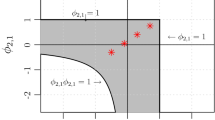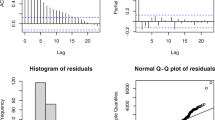Abstract
The autoregressive fractionally integrated moving average (ARFIMA) processes are one of the best-known classes of long-memory models. In the package afmtools for R, we have implemented a number of statistical tools for analyzing ARFIMA models. In particular, this package contains functions for parameter estimation, exact autocovariance calculation, predictive ability testing and impulse response function computation, among others. Furthermore, the implemented methods are illustrated with applications to real-life time series.








Similar content being viewed by others
References
Akaike H (1974) A new look at the statistical model identification. IEEE Trans Automat Contr 19(6):716–723
Andrews D (1991) Heteroskedasticity and autocorrelation consistent covariance matrix estimation. Econometrica 59(3):817–858
Andrews D, Monahan JC (1992) An improved heteroskedasticity and autocorrelation consistent covariance matrix estimator. Econometrica 60(4):953–966
Beran J (1994) Statistics for long-memory processes. Chapman & Hall, New York
Bisaglia L, Guégan D (1998) A comparison of techniques of estimation in long-memory processes. Comput Stat Data Anal 27:61–81
Contreras-Reyes JE, Goerg G, Palma W (2011) Estimation, diagnostic and forecasting Functions for ARFIMA models. R package version 0.1.8. http://cran.r-project.org/web/packages/afmtools/index.html
Contreras-Reyes J, Idrovo B (2011) En busca de un modelo Benchmark Univariado para predecir la tasa de desempleo de Chile. Cuad Econ 30(55):105–125
Dahlhaus R (1989) Efficient parameter estimation for self-similar processes. Ann Stat 17(4):1749–1766
Diebold F, Mariano R (1995) Comparing predictive accuracy. J Bus Econ Stat 13(3):253–263
Giacomini R, White H (2006) Tests of conditional predictive ability. Econometrica 74(6):1545–1578
Gradshteyn IS, Ryzhik IM (2007) Table of Integrals, Series, and Products, 7th edn. Elsevier, Amsterdam
Granger CW, Joyeux R (1980) An introduction to long-memory time series models and fractional differencing. J Time Ser Anal 1:15–29
Haslett J, Raftery AE (1989) Space-time modelling with long-memory dependence: assessing Ireland’s wind power resource (with Discussion). Appl Stat 38(1):1–50
Hassler U, Kokoszka PS (2010) Impulse responses of fractionally integrated processes with long memory. Economet Theor 26(6):1861–1885
Hipel KW, McLeod AI (1994) Time series modelling of water resources and environmental systems. Elsevier, Amsterdam
Hosking JR (1981) Fractional differencing. Biometrika 68(1):165–176
Hyndman RJ, Khandakar Y (2008) Automatic time series forecasting: the forecast Package for R. J Stat Softw 27(3):1–22
Kokoszka PS, Taqqu MS (1995) Fractional ARIMA with stable innovations. Stoch Proc Appl 60(1):19–47
Lieberman O, Phillips PCB (2008) A complete asymptotic series for the autocovariance function of a long memory process. J Econometrics 147(1):99–103
Lumley A, Heagerty P (1999) Weighted Empirical adaptive variance estimators for correlated data regression. J Roy Stat Soc B 61(2):459–477
Newey WK, West KD (1987) A simple, positive semidefinite, Heteroskedasticity and autocorrelation consistent covariance matrix. Econometrica 55(3):703–708
Palma W (2007) Long-memory time series, theory and methods. Wiley, Hoboken
Palma W, Olea R (2010) An efficient estimator for locally stationary Gaussian long-memory processes. Ann Stat 38(5):2958–2997
Palma W, Olea R, Ferreira G (2013) Estimation and forecasting of locally stationary processes. J Forecast 32(1):86–96
Peiris M, Perera B (1988) On prediction with fractionally differenced ARIMA models. J Time Ser Anal 9(3):215–220
Piessens R, de Doncker-Kapenga E, Uberhuber C, Kahaner D (1983) Quadpack: a subroutine package for automatic integration. Springer, New York
R Development Core Team (2012) R: A language and environment for statistical computing. Foundation for Statistical Computing, Vienna. ISBN 3-900051-07-0. http://www.R-project.org
Singleton RC (1979) Mixed radix fast fourier transforms. In: IEEE Digital Signal Processing Committee (eds) Programs for Digital Signal Processing. IEEE Press, New York
Sowell F (1992) Maximum likelihood estimation of stationary univariate fractionally integrated time series models. J Econom 53(1–3):165–188
Whittle P (1953) Estimation and information in stationary time series. Ark Mat 2:423–434
Wold H (1938) A study in the analysis of stationary time series, vol 53. Almqvist and Wiksell, Uppsala, pp 165–188
Zeileis A (2004) Econometric Computing with HC and HAC Covariance Matrix Estimators. J Stat Softw 11(10):1–17
Zeileis A (2006) Object-oriented Computation of Sandwich Estimators. J Stat Softw 16(9):1–16
Acknowledgments
Wilfredo Palma would like to thank the support from Fondecyt Grant 1120758. The authors thank the editor, the co-editor and an anonymous referee for their helpful comments and suggestions.
Author information
Authors and Affiliations
Corresponding author
Rights and permissions
About this article
Cite this article
Contreras-Reyes, J.E., Palma, W. Statistical analysis of autoregressive fractionally integrated moving average models in R. Comput Stat 28, 2309–2331 (2013). https://doi.org/10.1007/s00180-013-0408-7
Received:
Accepted:
Published:
Issue Date:
DOI: https://doi.org/10.1007/s00180-013-0408-7




